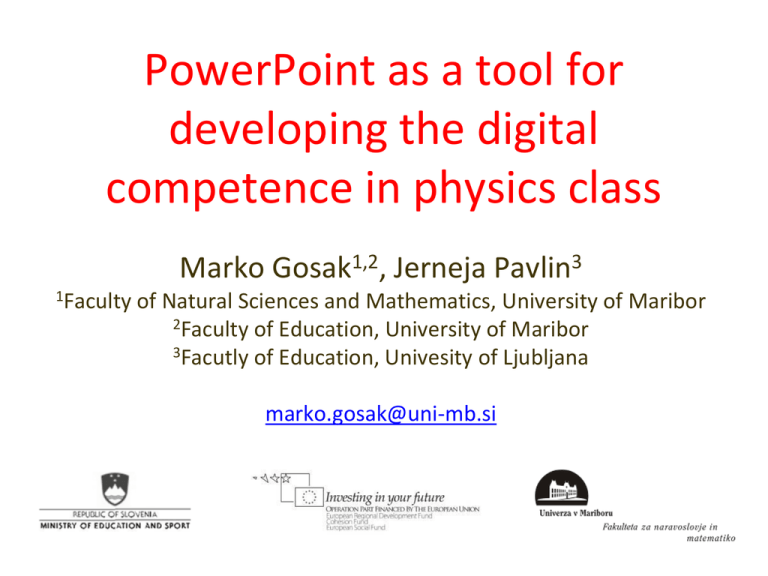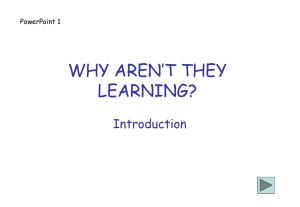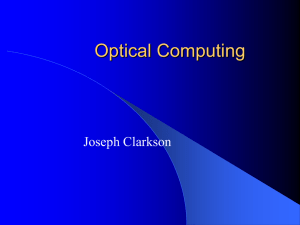Primary and secondary school physics: utilization of the PowerPoint
advertisement

PowerPoint as a tool for developing the digital competence in physics class Marko Gosak1,2, Jerneja Pavlin3 1Faculty of Natural Sciences and Mathematics, University of Maribor 2Faculty of Education, University of Maribor 3Facutly of Education, Univesity of Ljubljana marko.gosak@uni-mb.si Natural science subjects – a gateway for the development of the key and generic competences Digital competence Involves the use of computer and other information communication technology tools Numerous possibilities to promote the digital competence during science subjects Computer as a tool for presenting results and new findings Computer supported laboratory work Internet as a source of new information Web textbooks, applets and many other applications… Representative educational materials for physics lessons 1. ELECTRIC CIRCUITS: • primary school physics, • group experimental work, • each group present their new findings with a PowerPoint presentation. 2. OPTICAL PHENOMENA IN THE ATMOSPHERE: • secondary school physics, • text- and web-based learning in groups, • each group present their new findings with a PowerPoint presentation. DIGITAL COMPETENCE interconnected with: Ability to work with others in groups, ability of organizing and planning of the work, verbal and oral communication, ability of collecting data and selection of data… 1. Electric circuits Each group receives a different worksheet with instructions for experimental work Characteristic worksheet: 1. Electric circuits MAIN IDEA – pupils are required to create PowerPoint presentations with their results and new findings and present them afterwards to their schoolfellows. The teacher gives first instructions on using PowerPoint effectively. Characteristic slides from the exemplary PowerPoint presentation: 1. Electric circuits – materials in school practice Some slides made by pupils: Poskus 1 Potrebščine: Napetostni vir (6V) 3 enake žarnice Električne žice Ugotovitve: Vedno več žarnic je priključenih čim slabše svetijo žarnice. Ta vezava je zaporedna. Če eno od žarnic odviješ vse ugasnejo. Slika 2 I2=0,39 A U2=6,0 V 1. Electric circuits – materials in school practice Evaluation of the materials Instruments: - pre-questionnaire and a questionnaire, - teacher’s observations and comments. Sample: - 90 pupils from three different primary schools, - predominantly rural population, - mixed socioeconomic status. 1. Electric circuits – materials in school practice Some results from the pre- and post- questionnaire: 1. Electric circuits – materials in school practice Some observations from the pre- and post- questionnaire: - 52 % of pupils knew that the appropriate number of indents is till 9, - 53 % of pupils have learned something new, - new learned things were linked to the editing of the figures and tables, general knowledge about the contents of the presentation… Some observations from the teachers: - 80 % of pupils took into account all the suggestions for designing the slides, - the oral presentations were successfully carried out by 60 % of pupils, - problems were not a consequence of the lack of knowledge but lack of experiences with the oral presentations. 2. Optical phenomena in the atmosphere Each group receives a worksheet on a different subject. Link to additional graphical materials. Links to web pages where additional information can be gathered. Instructions on how to find useful information via web browsers. MAIN IDEA – pupils are required to create PowerPoint presentations with their new findings and present them afterwards to their schoolfellows. 2. Optical phenomena in the atmosphere Colours of the sky and of the Sun: Sonce aerosol molekula zraka opazovalec 2. Optical phenomena in the atmosphere The rainbow: Refractions in the air: sončna svetloba odbita svetloba sliko predmeta vidimo obrnjeno in pod predmetom 2. Optical phenomena in the atmosphere Halos: Aureola and glory: 22° 22° 2. Optical phenomena in the atmosphere – materials in school practice Evaluation of the materials Instruments: - pre-questionnaire and a questionnaire, - teacher’s observations and comments. Sample: 120 students from five different secondary schools. Results: - students are quite well acquainted with PowerPoint, - progress has been noticed by designing proper slides (font size, bold fonts etc.), - students prefer a lot of special effects and animations. Teachers report: - students had difficulties by their oral presentations due to lack of experiences. Conclusion NATIONAL PROJECT: “Development of Natural Science Competences” MATERIALS: Electric circuits, Optical phenomena in the atmosphere POWERPOINT IN THE CLASSROOM: Designing new educational materials. Fostering the development of the digital competence and several others as well. Students: • like to handle with PP, • are quite familiar with PP, • lack of expertise on more advanced handling with PowerPoint, • lack on experience with oral presentations. Thank you for your attention!






